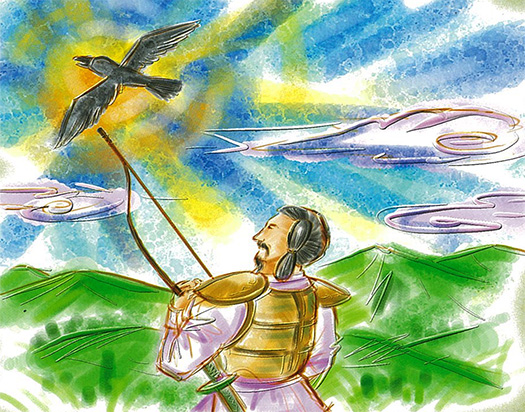

熊野探訪篇から本筋の「神武東征」篇への岐路にはヤタガラスという重要キャラ。
わたしは率直に言って、カラスに対して好印象を持つということはありません。最近のヤツらは子育て時期の凶暴なふるまいが問題視されてきている。札幌の市街地で人間を攻撃する場面が多く報告されているし、わたし自身も昨年、かれらからの攻撃にさらされてしまった。
いつもの散歩道でギャーギャー威嚇的な鳴き声を響き渡らせていた。しばらくぶりの遭遇だったので「バンザイ」スタイルでの防御を忘れていたら、不意にキック攻撃を浴びてしまったのですね。
子育て時期に由来していることは理解はしているけれど、どうにも嫌悪感を持つ(笑)。まぁこれも現代・人新世での野生動物との共存ルール確立までのプロセスなのでしょうか?
現代では人類は都市という環境を生成し、そこからおびただしい生活廃棄物をまき散らしてきている。その「必殺掃除人」として本来野生だったカラスたちが共存関係になってきた。毎朝、憎々しげなかれらの鳴き声には悩まされるけれど、そのエサは人類が自然を汚し続けているものでもある。
「オレたちがこんな暮らし方になって来たのは、オマエたちの足らざるを補ってやっているのだぜ」というかれらの「主張」がこだましても来る(笑)。いまのところは、人間の側で「バンザイ」ポーズでの折り合いを付けながら、共存していくべきなのでしょう。
しかしそう考えると、都市集住がそれほど進んでいなかった古代、神武東征の時代には当然人口規模もまばらであって、かれらカラス族も現代とは違った生活スタイルだったことが想像できる。かれら本来の森での暮らし方を生きていたのだろう。
いやむしろ共生可能な動物種として人類を見ていて、人類の増加がかれらにとっても種の利益になると信じて、ヘルプを試みていたとも考えられる(笑)。それが人間の側にも伝播して、生物種的な親和性表現としてこのような八咫烏神話というものは生成したのかも知れない。
神武帝が東征し国家を形成して集住様式が列島人類の普遍スタイルになれば「オレたちの縄張りも一気に拡大が図れるぜ」という妄想。・・・たしかにまったくの妄想ですが、古代に於いて人類はカラス族に対して現代とはまた違う感受性を持っていただろうことは間違いがない。


熊野三山ではそれぞれで異なるヤタガラスのシルシを形象化している。
どうもこの文化圏を考証してきて、熊野というのは縄文由来の自然信仰が色濃く感じられる。そういった自然観が反映しているのが熊野信仰と考えると、かれらカラス族との「共生関係」というものが心理のベースにあるようにも思える。キトラ古墳壁画にもヤタガラスが描かれているとも言われるし、たぶん現代とは相当違う対カラス認識が、列島人類社会には根付いていたのだろう。
そう考えるとあんまり憎しみの対象とばかり見てはいけないのだろうか。う〜ん、でもやっぱりあのヤツらの攻撃は憎たらしい!
English version⬇
Species Coexistence with the Ancient Yatagarasu Tribe: Imperial Mythology and Kumano Journey-17
Why are ravens, the objects of hatred that attack humans even when they are raising their young, friendly in the mythology of the imperial lineage? …
At the crossroads from the Kumano expedition to the main story, “Jinmu’s Eastern Expedition,” there is an important character named “Yatagarasu” (raven).
Frankly speaking, I do not have a favorable impression of ravens. Recently they have become a problem because of their ferocious behavior when they are raising their young. There have been many reports of them attacking humans in the urban area of Sapporo, and I myself was subjected to an attack by them last year.
Last year, I myself was attacked by one myself. It was on my usual walking path, and it was making a menacing noise that echoed through the air. Since it had been a while since I had encountered them, I had forgotten to defend myself in the “banzai” style and was unexpectedly subjected to a kicking attack.
I understand that it stems from the child-rearing period, but I can’t help but feel disgusted (laughs). Well, is this also the process of establishing rules for coexistence with wild animals in the modern/humanocene era?
In the modern age, human beings have generated the environment of cities and have scattered an enormous amount of waste from their daily lives. Crows, which were originally wild, have come to coexist with humans as “cleaners. The crows’ hateful cawing annoys me every morning, but their food is the same thing that humans have been polluting nature with.
Their “insistence” that “the reason we have come to live this way is to compensate for your deficiencies” (laughs). For the time being, we humans should coexist with them while making peace with them by adopting a “banzai” pose.
However, when we think about it, we can imagine that in ancient times, when urban settlements were not so advanced and the population was sparsely populated during the Jinmu expedition, the Crow tribe had a different way of life from that of today. It is likely that they lived their original way of life in the forest.
They may have seen humans as a symbiotic animal species, and they may have believed that the increase in the number of humans would be beneficial to their species and tried to help (laugh). This may have spread to the human side, creating this yatagarasu myth as an expression of species affinity.
If the Jinmu Emperor conquered the east and formed a nation, and the residential style became the universal style of the human race in the archipelago, “We can expand our territory at once,” was the delusion. It is true that this is a total delusion, but there is no doubt that humans in ancient times would have had a different sensitivity to the Crow tribe than they do today.
Each of the three mountains of Kumano has a different yatagarasu shirushi symbol.
After studying this cultural area, I feel that Kumano is strongly influenced by Jomon-derived nature beliefs. If we consider the Kumano beliefs to be a reflection of this view of nature, it would seem that a “symbiotic relationship” with the raven tribe is at the base of the psychology of the people. It is said that ravens are depicted in the murals of the Kitora burial mound, and perhaps a perception of ravens that was quite different from that of today took root in the human society of the archipelago.
Considering this, I wonder if we should not see them only as objects of hatred. But I still hate their attacks!
Posted on 1月 19th, 2024 by 三木 奎吾
Filed under: 日本社会・文化研究







コメントを投稿
「※誹謗中傷や、悪意のある書き込み、営利目的などのコメントを防ぐために、投稿された全てのコメントは一時的に保留されますのでご了承ください。」
You must be logged in to post a comment.